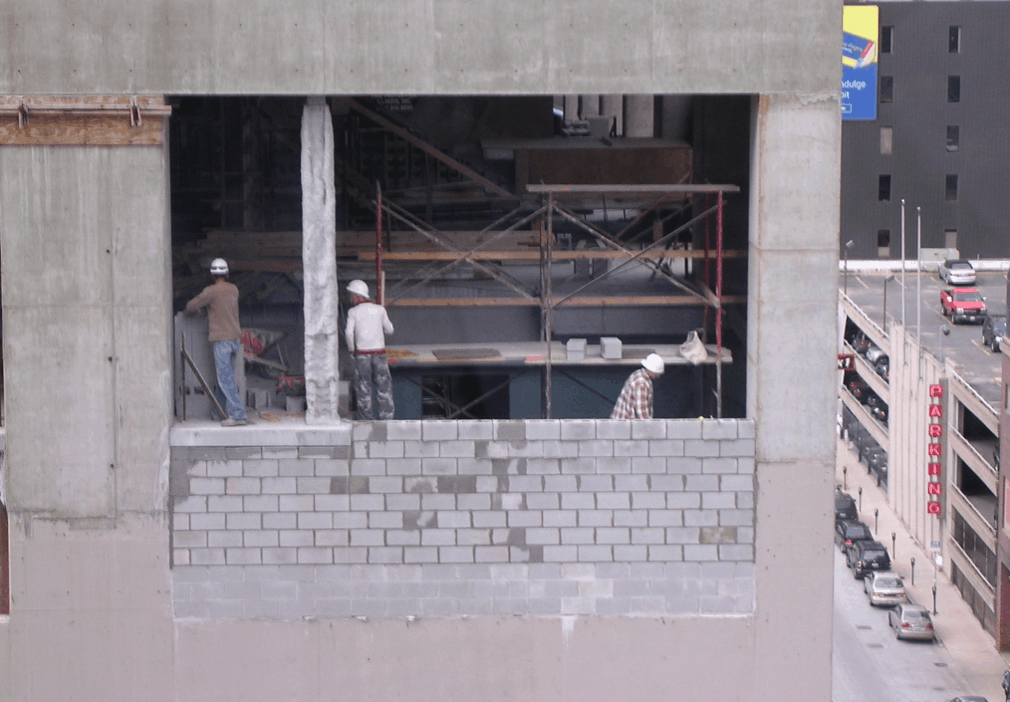Do They See the Hazard? [Hazard Recognition]

Do They See the Hazard? [Hazard Recognition]
Why are these workers ignoring an obvious hazard? Have they ever had training in hazard recognition?
This picture was taken several years ago in Chicago. As you can see, there is no fall protection for the workers and no rails to prevent a fall. In addition, they were tossing concrete blocks and catching them. What would have happened to vehicles or bicyclists below if they had missed one and it went over the edge?
Hazard Recognition
Some Hazards are easier to recognize. Some are harder to recognize. On the Energy Wheel below the first two Hazards (going clockwise) are the easy ones to recognize. People easily spot long drops (Gravity) and things in motion.

Thus, the Hazard in the example at the start of this article (Gravity – either falling from height or dropping something from height) should be easy for the workers to spot. So, why aren’t they doing something about it?
Safety Manager’s and Construction Site Manager’s Job
Because the Hazard at the construction site in the picture above is an EASY one to recognize, I think we can assume that the workers have become complacent about the Hazard. After all, two of the workers are standing on the edge with their backs to a seven-story fall.
My question at this point is … Where were management and the supervision?
You might think that this was just a mistake. These guys took a shortcut and nobody found out about it. But I know better.
I was teaching a public 2-Day TapRooT® Root Cause Analysis Course on the seventh floor of a hotel right across the street. I could see the General Contractor’s sign below. I called them and asked for the Safety Manager. I got their voice mail. I left a message about what I had seen. I called back and got the Safety Manager’s e-mail address. I sent him a link to a short video of the work.
What happened? Nothing. The next day they completed the wall using the same unsafe practices they had used on day one. Even though I left my phone number and my e-mail address, I never heard a word from the Safety Manager.
Much later, I thought that maybe I should have gone across the street to the construction site’s supervisor’s office. But it was too late. I had already left Chicago.
Hazard Complacency
Why were the worker’s complacent about the Hazard? My guess would be that the General Contractor’s Management, Supervision, and even the Safety Manager were complacent about Hazards.
My guess would be that they weren’t:
- performing pre-job hazard analysis
- performing job-site audits/coaching
- using Personal Safety Assessments (PSA)
This was a precursor to a fatality. The Safety Manager was informed and, at least as far as I could see, nothing was done.
What would you do if you were the Safety Manager or the Site Supervisor? Would you correct the workers?
If failures to recognize even the most basic Hazards are common at this site/company .. there is a generic problem (a Generic Cause) that needs to be addressed.
How would you address it if you were hired as the NEW Safety Manager?
Stopping Human Error Training
We have some ideas and we’ve included them in our new course: Stopping Human Error.
Want to learn more about the course? See this link:
Stopping Human Error Course INFO
The main techniques we would recommend using would be:
- Stopping Normalization of Deviation
- Pre-Job Hazard Analysis
- Pre-Job Briefings
- Personal Safety Assessment
- Observation and Coaching
We teach all about these techniques in the Stopping Human Error Training.
When is the next course? September 15-16.
Where is the next course? Knoxville, Tennessee.
Get registered at THIS LINK.
Don’t wait! As part of our COVID prevention Safeguards, attendance at this course is limited. Register today!



